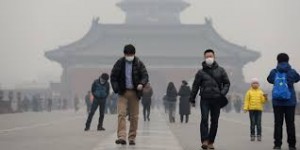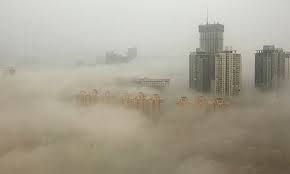I ran into an article today that discussed particulate matter and pollution being over 50 times the WHO recommendations through regions of China this week. While we may have discussed some of this previously, it is astounding that pollution levels could reach this high. The smog can be so thick, buildings become completely invisible and in some cases signs appear to be floating in mid air.
While China has been working to decrease these numbers, pollution will continue to rise until it is estimated to peak around 2030. It can also be noted that there is no switch to just shut down smog. It will last and linger for decades after production and carbon emissions slow.
This is a major issue in China that will continue to magnify as death rates continue to rise and rise in many of these urban areas. Now that growth is starting to slow throughout the nation, maybe the use of coal and other harmful power sources will be replaced with more efficient, safer practices. The rapid emergence of China as a production powerhouse led to the absurd amount of carbon emissions, but hopefully those will begin to table soon. For the safety of the world as well as the safety of China’s people actions need to be taken soon .
.

It has been proven that one day of breathing in Beijing’s air is the equivalent of smoking a pack of cigarettes. The government has long told its citizens that the smog related to the rapid increase in industrial production was “overcast” weather and was not hazardous; however, when the population increasingly faces respiratory ailments they will need to come to terms with the reality of their country’s production and the damage that they have inflicted on the regions environment.
As someone lived in Beijing for a summer, this is absolutely true. My lungs hurt at the end of the day towards the end of the second month.
This isn’t even a domestic problem anymore: Japan and Korea constantly levy complaints against China regarding Chinese pollution wafting into Japanese and Korean cities. Chinese pollution has even made its way to California. I have to wonder if a better international infrastructure for enforcing pollution-based reparations would further incentivize China to lower pollution levels in light of being penalized. Probably not, but it would be worth a shot.
While it may no longer be the case, as of 2010 certain forms of pollution (SOx) had actually started declining even as PM2.5 pollution continued to worsen. Fewer plants inefficiently burning unwashed coal … replaced by lots of inefficient diesels. I’m not an environmental scientist to know what the base level of particulate matter is – the soils of much of the north China plain are wind-deposited loess – but the air has never been clean. To what extent the current pollution is a result of climate change (perhaps enhanced by attempts to farm near-desert regions), and how much is man-made? The US experience is that horrific air pollution can be reversed in a span of a decade or less (as happened in the LA basin), when it is of human origin. Stopping the winds from blowing dirt from west to east is not something won’t happen, and if rainfall patterns shift, China itself can’t do much about the desert expanding.